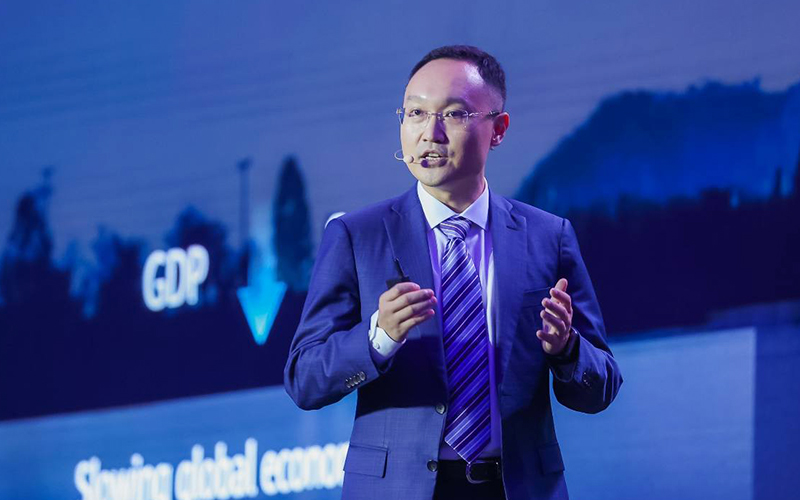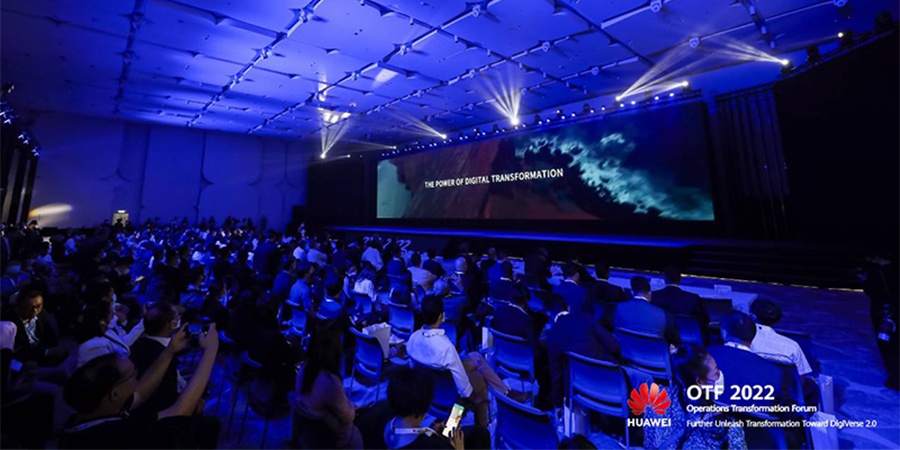Huawei’s 7th Operations Transformation Forum (OTF 2022), with the theme of “Further Unleash Transformation Toward DigiVerse 2.0,” was held in Bangkok, Thailand from October 26-27, 2022.
A thought leadership event for digital transformation in the telecom industry, this year’s OTF explores the evolution of this journey and strategies for unleashing the value of a digital universe — DigiVerse 2.0.
“We need to keep pace with the times and upgrade to adapt. This is a continuous journey of embracing DigiVerse. Huawei is willing to be your most reliable partner in the digital transformation journey. Hence, Huawei is willing to open up our facilities, capabilities and resources as much as possible and work with all of you to win the future together,” said Austin YOU, vice president, global technical service, Huawei.
In his presentation during OTF 2022 entitled “Together, Lighting Up the Digital Future,” YOU mentioned that despite all the great uncertainties today — challenges from global economy, COVID-19 as well as energy and environmental crises — the trend towards digitalization has not changed.
“Digitalization used to make some companies better, but today it's the key to their survival. Only digital-intelligent companies will survive well in the future,” YOU pointed out. This correlates to the fact that the digital economy’s growth rate is twice that of the traditional economy on average, indicating that it has become the engine of economic development in many countries.

Austin YOU, Vice President, Global Technical Service, Huawei
3 Necessary Carrier Upgrades for a Digital Future
It is indeed a time full of opportunities for operators who are the enablers of digital intelligence. Thus, to adapt to the future, YOU suggests that carriers should pay attention to two things: how to implement digital intelligence for core services to optimize costs and perform value-based operations for existing users; and how to explore the second curve and new track of services based on differentiated capabilities to ensure new growth engines in the future.
To be able to keep pace in the digital world, Huawei put forward three necessary carrier upgrades: business, operation and standard.
For business upgrades, the key is having new experiences, scenarios and users. YOU gave examples such as finding an effective Connectivity+ model to get more sustainable value; upgrading the digital life service based on carriers' data and expansion capabilities; and transforming the original IT departments of each enterprise to become "carriers" of each department.
For operation upgrades, future O&M models should have man-to-machine coordination, with AI at the core. More digital employees will be available to assist people, and at the same time, people will learn new technologies and serve new services to support the rapid development of carriers. Moreover, transforming people from being “in the loop” to “on the loop” means machines will be able to independently take charge of a large number of repetitive tasks, and people will step back and only "monitor the process.”
For standard upgrades, such topics as values, capabilities and personnel skills evaluation — each supported by native AI — were emphasized. “We must move from diverse to converse. Only in this way, can we work together to solve common issues in the industry,” YOU explained. Huawei has worked with industry partners like TM Forum and CCSA in developing the VoF framework, the autonomous network maturity standard and the BizDevOps standard.
YOU also discussed Huawei’s three horizon development paths and strategies as they believe that “digital transformation is a process that gradually expands boundaries and scales from the inside out.” The first and second horizons are about using digital intelligence technologies to enable Huawei’s core businesses as well as to better enable carriers' business processes and platforms to achieve business success. Lastly, they will work with carriers to enable digital transformation for diverse industries and share the dividends of the industry's digital economy.
Launching Digital Operation Transformation Digiverse 2.0
Digital transformation will be the biggest opportunity for operators over the next decade. They can not only deliver the ultimate customer experience and enhance O&M mode, but can also continually develop new business models and services.
Moving toward digital operations transformation 2.0, further unleash transformation value, Huawei supports three layers of transformation. First is the digital services transformation, where there will be a shift from pure connectivity services to connectivity plus digital services, such as fintech, CPaaS and other industry vertical services. These digital services will account for 40–60% of total revenue in the future.
Next is digital operations transformation, which requires a new digital operating model to improve agility and productivity. By fully leveraging the value of smart data, operations can transition from being network-oriented to being customer-oriented. In the future, it is expected 80% of business decisions to be driven by data, further facilitating value-based operations.
Lastly, carriers' infrastructures must transform to become more intelligent, reliable, efficient and green.
“Digital operations transformation is a systematic project, which cannot be done overnight. But by remaining customer-centric, creating business value and keeping on going, carriers will achieve greater success.
The launch of Digital Operation Transformation DigiVerse 2.0 to further unleash transformation value offers four significant improvements: the move from clean to smart data; the change from on-premise or cloud to hybrid cloud deployment; the move from single-scenario to cross-scenario collaboration; and the extension of ToC and ToH to enable digital transformation in ToB industries.
The four C.O.D.E dimensions guide Huawei on its DigiVerse journey to continuously unleash the full power of transformation. This covers Cloud-based Target Architecture, Smart Operations, Data-driven Decisions and Industry Enablement.
Huawei has already set up seven regional smart operations centers located across the Asia Pacific, Middle East, North and South Africa, Latin America, Europe and China. Additionally, they have five intelligent transformation research centers around the world that involve 200 senior consulting experts and more than 4,000 R&D teams in various fields. In addition, Huawei Service has gathered more than 20,000 developers to build more advanced development systems.
To learn more about Huawei Operations Transformation Forum 2022, please click here.
